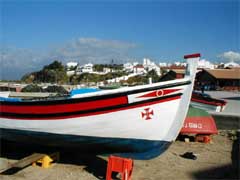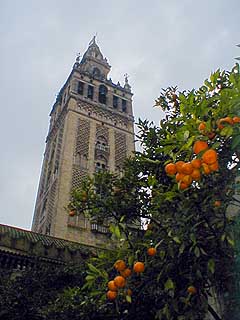|
 Three thousand years ago, the Phoenicians referred to the land of seven hills above the River Tagus as Alis Ubbo, delightful shore. Today Lisbon recalls its glory days as seat of a vast 16th century empire. Sidewalk mosaics lead the visitor through this mosaic of a cityback through the centuries and forward into the 21st. Trams ascend narrow cobbled streets past blue-tiled houses and mysterious passageways, to viewpoints over the Moorish castle and the wide river estuary. Dramatic new structures by Siza Vieira sit harmoniously alongside Baroque and Neoclassical buildings. Busy sidewalk cafés alternate with elegant plazas and tree-lined avenues. Where this ancient city meets its river, Lisbon's greatest urban renewal project unfolds around the Expo '98 site. Three thousand years ago, the Phoenicians referred to the land of seven hills above the River Tagus as Alis Ubbo, delightful shore. Today Lisbon recalls its glory days as seat of a vast 16th century empire. Sidewalk mosaics lead the visitor through this mosaic of a cityback through the centuries and forward into the 21st. Trams ascend narrow cobbled streets past blue-tiled houses and mysterious passageways, to viewpoints over the Moorish castle and the wide river estuary. Dramatic new structures by Siza Vieira sit harmoniously alongside Baroque and Neoclassical buildings. Busy sidewalk cafés alternate with elegant plazas and tree-lined avenues. Where this ancient city meets its river, Lisbon's greatest urban renewal project unfolds around the Expo '98 site.
Nearby Sintra, Lord Byron's Glorious Eden, once provided a summer retreat for royalty and courtiers. Pena Palace and Palacio da Vila stand as architectural opposites, each representative of its time in the sun. Strolling narrow alleys and the network of small roads that ascend towards the Serra da Sintra, the visitor soon discovers Byron's Eden of private palaces and fountains, extravagant gardens and Moorish fortress. Nowadays, this ancient hill town sells fine crafts and, of course, the emblematic Sintra cake in its many welcoming cafés.
To the east of Lisbon is the vast, rolling plain of the Alentejo. Here golden wheat fields are punctuated with white-washed towns, cork forests, and silver-leafed olive trees that march up and down the rolling hills like a great army. Évora is a UNESCO World Heritage Site, a city of Roman remains, blue-tiled Baroque churches, an ancient university, and superb craft shops with pottery, rugs, and wooden carvings from all over the region.
 Turning south, the road winds through the town of Beja, capital of the southern Alentejo. Settled since Roman times, this market center for wheat, olives and cork is richly evocative of its past. Traveling under the shadow of the Serra de Monchique, the road meets the coast near Lagos. Here slave-ships unloaded their human cargo in the 15th century. As elsewhere in Portugal, wealth from the Discoveries poured into churches, and silver, gold, and 18th century azulejos are a reminder of those proud days. Today Lagos is a pretty Algarve town of bright plazas filled with bougainvillea and lovely beaches. Turning south, the road winds through the town of Beja, capital of the southern Alentejo. Settled since Roman times, this market center for wheat, olives and cork is richly evocative of its past. Traveling under the shadow of the Serra de Monchique, the road meets the coast near Lagos. Here slave-ships unloaded their human cargo in the 15th century. As elsewhere in Portugal, wealth from the Discoveries poured into churches, and silver, gold, and 18th century azulejos are a reminder of those proud days. Today Lagos is a pretty Algarve town of bright plazas filled with bougainvillea and lovely beaches.
Across the Portuguese border lies the Region of Andalucia, where Sevilla, on the Guadalquivir River, was the richest city in western Europe in the 16th century. An ancient capital of Moorish and Christian kings, their legacy is visible throughout this seductively beautiful city. Follow in Don Juan's footstepspast modest homes and palaces, between window grilles and patios, in and out of crowded bodegas. Fortified with a fino and plate of almonds in Plaza Santa Cruz, watch an artist apply generous daubs of orange to his canvas to surround you with orange trees. Listen for the click of castanets, inhale the sweet jasmine, and remember that Santa Teresa once said, "Anyone who can avoid committing sin in Sevilla is very lucky indeed!"
 |
| Day |
Overnight |
Highlights |
Hotel |
| 1 |
Lisbon |
Castle, Alfama, Belem |
city center 4-star hotel |
| 2 |
Lisbon |
Sintra & coast |
city center 4-star hotel |
| 3 |
Évora |
Walking tour |
pousada, former convent |
| 4 |
Alvor |
Beja |
beautiful beach hotel |
| 5 |
Alvor |
Lagos |
beautiful beach hotel |
| 6 |
Sevilla |
Cathedral & walking tour |
18th century merchant's house in old quarter |
| 7 |
Sevilla |
Alcázar & flamenco tablao |
18th century merchant's house in old quarter |
| 8 |
Transfer out |
|
|
